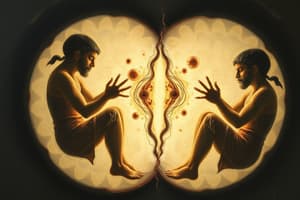Podcast
Questions and Answers
What is the haploid number of chromosomes present in each gamete?
What is the haploid number of chromosomes present in each gamete?
- 23 chromosomes (correct)
- 44 chromosomes
- 22 chromosomes
- 46 chromosomes
During which phase of mitosis do chromosomes begin to coil and condense?
During which phase of mitosis do chromosomes begin to coil and condense?
- Prometaphase
- Telophase
- Prophase (correct)
- Anaphase
How many pairs of sex chromosomes do humans have?
How many pairs of sex chromosomes do humans have?
- 2 pairs
- 22 pairs
- 1 pair (correct)
- 23 pairs
What occurs at metaphase during mitosis?
What occurs at metaphase during mitosis?
Which process gives rise to two genetically identical daughter cells?
Which process gives rise to two genetically identical daughter cells?
What are primordial germ cells responsible for during embryonic development?
What are primordial germ cells responsible for during embryonic development?
What determines the traits of a new individual?
What determines the traits of a new individual?
Which cells show 23 homologous pairs to form the diploid number of chromosomes?
Which cells show 23 homologous pairs to form the diploid number of chromosomes?
What determines genetic sex in individuals?
What determines genetic sex in individuals?
Where do primordial germ cells (PGCs) originate during development?
Where do primordial germ cells (PGCs) originate during development?
What happens to primordial germ cells during their migration to the gonads?
What happens to primordial germ cells during their migration to the gonads?
What is the primary purpose of gametogenesis in germ cells?
What is the primary purpose of gametogenesis in germ cells?
What is believed to be the origin of teratomas?
What is believed to be the origin of teratomas?
Flashcards are hidden until you start studying
Study Notes
Gametogenesis
- Gametes have a haploid number of 23 chromosomes.
- Fertilization restores the diploid number of 46 chromosomes.
Mitosis
- Creates two genetically identical daughter cells from a single parent cell.
- Each daughter cell inherits 46 chromosomes.
- Chromosomes replicate their DNA before mitosis.
- During replication, chromosomes are long and diffuse.
- As mitosis begins, chromosomes condense and shorten.
- Each chromosome consists of two chromatids joined at the centromere.
- Chromatids become distinguishable during prometaphase.
- Chromosomes align in the equatorial plane during metaphase.
Primordial Germ Cells (PGCs)
- Formed in the epiblast during the second week of development.
- PGCs migrate to the yolk sac wall.
- Migrate from the yolk sac to the developing gonads during the fourth week.
- Arrive in the gonad by the end of the fifth week.
- Number increases through mitotic divisions during migration.
- Undergo gametogenesis in preparation for fertilization.
Clinical Correlate: Teratomas
- Tumors of disputed origin containing various tissues.
- May arise from pluripotent stem cells.
The Chromosome Theory of Inheritance
- Traits are determined by specific genes on chromosomes inherited from the father and mother.
- Humans have approximately 35,000 genes on 46 chromosomes.
- Genes on the same chromosome are linked genes.
- Somatic cells contain 23 homologous chromosome pairs.
- 22 pairs are autosomes, and one pair is sex chromosomes.
- Females have XX sex chromosomes; males have XY.
- One chromosome from each pair is maternal, one is paternal.
Studying That Suits You
Use AI to generate personalized quizzes and flashcards to suit your learning preferences.




